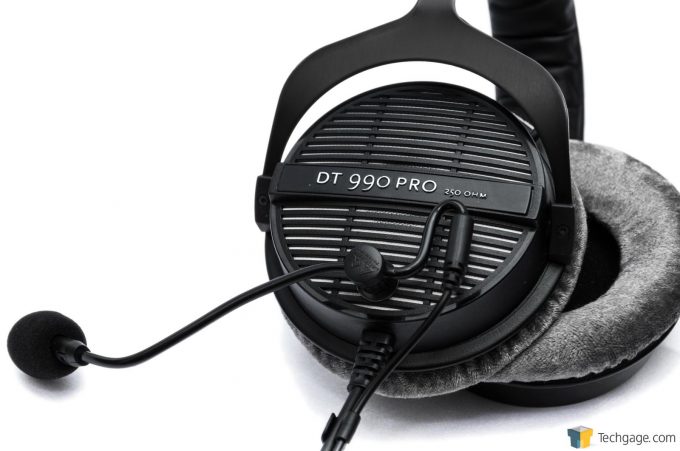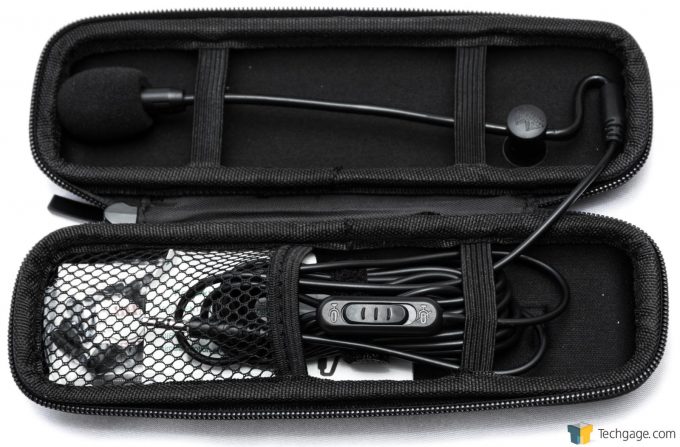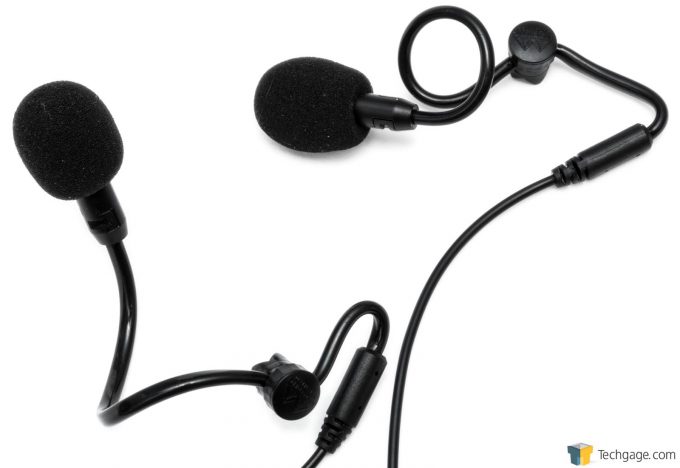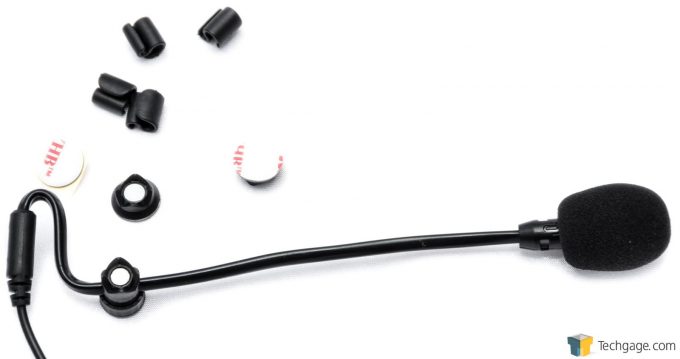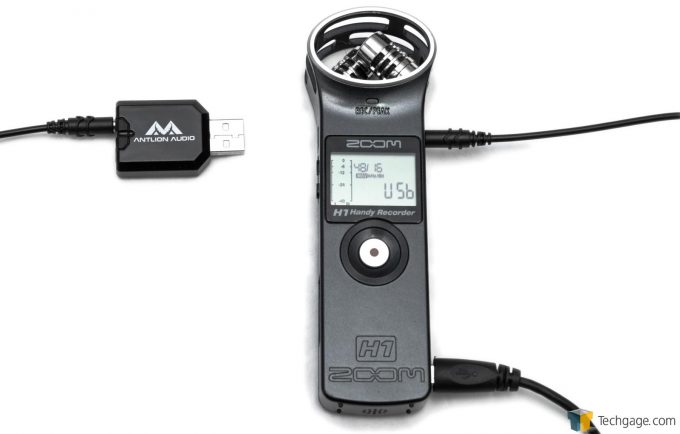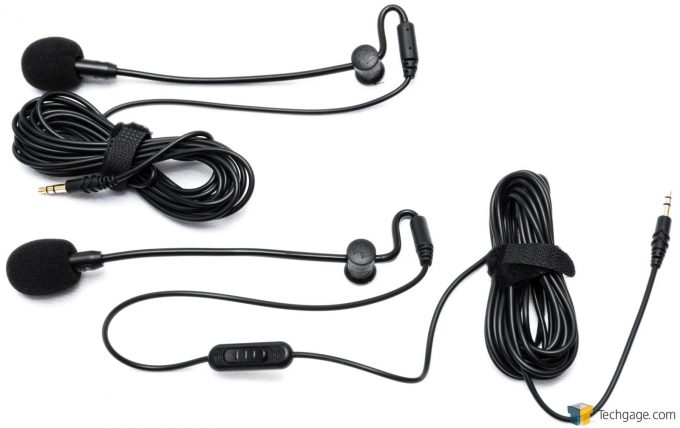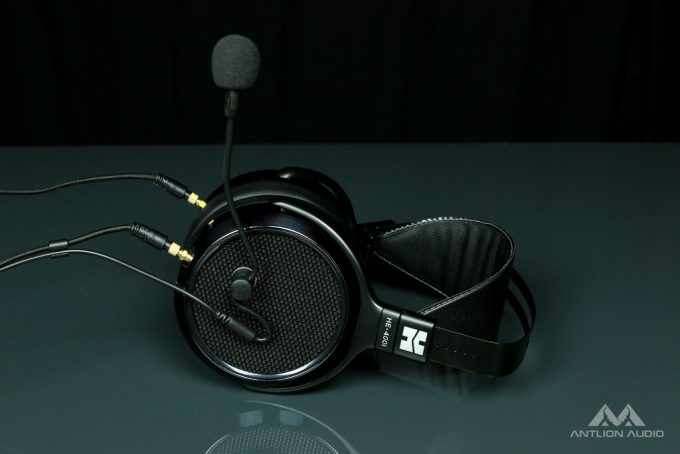- Qualcomm Launches Snapdragon 4 Gen 2 Mobile Platform
- AMD Launches Ryzen PRO 7000 Series Mobile & Desktop Platform
- Intel Launches Sleek Single-Slot Arc Pro A60 Workstation Graphics Card
- NVIDIA Announces Latest Ada Lovelace Additions: GeForce RTX 4060 Ti & RTX 4060
- Maxon Redshift With AMD Radeon GPU Rendering Support Now Available
Antlion ModMic 4.0 Attachable Headphone Microphone Review

Need a headset for gaming, but find gamer gear to be sorely lacking? Never mind the flashy lights and pretty plastic exteriors – get a pair of decent headphones and then stick a microphone on them! Antlion’s ModMic range is all about keeping the focus on audio quality, and letting you build the perfect headset without compromising sound or comfort.
When it comes to gaming and audio, there are often compromises. Let’s be honest here, compared to a proper pair of high-end headphones, gaming headsets suck. To add insult to injury, a lot of the premium gaming headsets cost more than a pair of decent headphones, and are significantly worse off in performance.
There are some, and so far, few exceptions to this rule – Kingston’s Cloud headsets are generally agreed upon as being very good sounding when compared to either other headsets or high-end headphones. So if you already have a decent pair of headphones, but you need comms for your team over VOIP, what can you do?
Up until recently, I have used two different microphones, and for the most part, they have served me well – but they are mics that are slightly outside their comfort zones. My needs are not explicitly limited to gaming, so what I have is overkill for most. Having a Blue Yeti in my face all the time gets a little cramped, and the lapel mic I have has been yanked one too many times from the port, simply because I forgot I was wearing it. This is where Antlion with the ModMic 4.0 come in.
ModMic Specs & Versions
The ModMic concept is about modifying a pair of headphones into becoming a full gaming headset. The procedure is very simple, as all it really involves is sticking a small clasp on the side of your headphones, which the microphone then attaches to via magnets. Not complicated right? It’s hardly a ‘mod’ in the true sense (I mean, there’s no duct tape involved for a start), but the simplicity of it is what makes it appealing.
Antlion have a number of different versions of the ModMic, each a refinement on the previous. The latest, and one under review here, is the ModMic 4.0. It comes in two distinct flavors on the pickup mode; either Omni-directional or Unidirectional (cardioid pattern). The names are fairly self-explanatory if you are familiar with the terms Omni (all), and Uni (single), as these define the sensitivity of the capsules used in the mics.
Omni mics are generally preferred where possible, as they don’t alter the incoming sound with vents or electrical canceling, while Unidirectional mics are best preferred in noisy environments (a form of passive background noise canceling). The good news is that if you are battling over which version to get, Antlion was kind enough to send over both types for review, so you can hear the difference for yourself.
The mics come packed in small, semi-hard cases, and are filled with everything you need to convert two pairs of headphones into headsets. Included in the pack is the ModMic itself (be it the Omni or Uni, with or without mute switch), two small adhesive pads on connectors, some cable clips for holding the mic cable to the headphone cable, and finally, an alcohol wipe for cleaning off your headphones before applying the pad.
The mic itself is a condenser type, which means that it’s very sensitive, and very clear. The downside is that it requires something called phantom power. Without getting too technical, phantom power is when power is supplied to the mic over the connected port (in this case, the 3.5mm jack), and is used to drive the mic’s internal circuits (such as the JFET on an electret), or to polarize the plates. For the ModMic, this means the mic input on the soundcard needs to provide at least 5.0 volts over the mic.
It might surprise you, but this isn’t as big of a deal as you’d might think, at least with PCs. Most internal soundcards on PCs these days can provide 2.5-5.0 volts of phantom (or biased) power over the mic-input (even consoles too), and as such, low-power condenser mics will work fine. If you are using a Mac however, then you are likely out of luck, since most Macs these days do not include power on the audio connectors (if they have any at all).
If your system doesn’t include a soundcard with phantom power, there are plenty of cheap USB soundcards that can. Antlion provide its own on its website, which is a re-branded C-Media CM119 USB DAC. The specifications for the two condenser mics are detailed below.
| Antlion ModMic 4.0 Options | ||
| Omni-Directional | Uni-Directional | |
| Sensitivity | -26 ± 3 dB | -38 ± 3 dB |
| Response | 30 Hz-17.5 kHz | 100 Hz–10 kHz |
| SNR | 58+ dB | >50+ dB |
| Impedance | 2.2 KΩ | 2.2 KΩ |
| Voltage | 1 to 10V | 1 to 10V |
| Max Current @ 2.0v | 500 µA | 500 µA |
| Max Input SPL | 110 dB | 110 dB |
As is typical, the unidirectional mic (or cardioid if you prefer), is more sensitive, at least on the front of the mic. This means your voice should be clearer, even at lower volumes, while still canceling out sound from behind the mic. Both mics also come with a very generous 3.3m (over 10ft) of cable, to reach behind those pesky desks, as well as flexible booms for precise positioning.
Testing
The tricky part about the ModMic, and something that Antlion spent a fair bit of time refining, is the clasp/connector. When I was told that this mic could hook up to any high-end pair of headphones, including mesh designs, I was skeptical. I have seen my fair share of adhesive pads over the years, and have not been impressed. Well, color me surprised when I found that the adhesive pad on the ModMic was not only really strong, it worked even on the vented panels of my Beyerdynamic DT990 headphones. This does mean that, if you do put it on incorrectly, it’s a bit of a pain to remove.
With the clasp in place on the headphones, you can simply snap the mic to the headphones with the mighty power of magnets! The clasp has a tooth-like mount on it as well, to help keep it aligned, and prevent it from drifting.
The flexible arm that extends out, really is flexible. You can do full loops, twist it around itself, and it’ll hold that position well – it’s a far cry from some of the other ‘flexible’ mics I’ve used in the past, where they basically meant rubber arms that bounce back to their manufactured shape.
The clasp on the mic itself, also has a small screw that tightens down on the arm, which allows the mic to be pulled back or extended out, providing more flexibility in regard to positioning the mic correctly. Speaking of which, positioning is critical, especially with the Uni mic, since it needs to be pointing at your mouth (rather than in front), in order to be best heard.
It does seem strange going into all this detail on just a microphone, but Antlion really has tried to cover all the possible use-cases with its design. It is flexible in more ways than one. While the design and concept is important, they mean little if the audio quality isn’t up to snuff as well. The ModMics are not audiophile mics, nor do they pretend to be, but as far as the mics go on integrated headsets, they are way above in the quality department.
The capsule in the ModMic is not only sensitive, as in volume, but also frequency response – they capture a broader range of frequencies, and as such, sound much more natural. This translates into clarity for those listening in on the other end of the line, with VOIP and Voice applications like Skype, Teamspeak, Mumble. You may not appreciate the difference, but your teammates will. If you happen to do voiceovers for videos as well, more power to you.
The ModMics will be tested against themselves for subjective quality when comparing the omni and the uni types. The two mics will be tested on two different recording inputs; the USB DAC Antlion provides on its website, as recommended to Mac users, as well as a Zoom H1 field recorder, as it provides a much better ADC, so you can hear what these mics are truly capable of.
Recording Samples
First of all, there is some bad news with the Unidirectional mic. It seems the current configuration is susceptible to certain radio frequencies in the ever crowded 2.4GHz range. This isn’t unheard of, and certain mics are more sensitive to others, depending on the diodes/transistors used in the capsule (condensers have some very basic electronics in them). Under testing, I found the biggest offender was a wireless land-line telephone, which produced a rather aggressive saw-wave sound. The mic also picked up some mains AC hum too.
Once the Uni mic is isolated from the offending phone, then things settle down and become more predictable. The mic is more sensitive than the Omni, and does have a greater proximity effect on the voice (slightly more bass). It does a better job at isolating faint background noise, such as from a distant PC fan. More direct noise immediately in front of the mic is still picked up – albeit, quietly.
While it’s bad news for the Uni mic, the Omni mic is the complete opposite, it far exceeded my expectations honestly, especially considering the price. There was no interference from radios or the mains, and bizarrely, very little background noise.
While I could tell almost immediately that the Omni mic was quieter, it wasn’t picking up as much ambient noise as I though it would. The clatter from the keyboard as I typed, the whistling of a fan, none of it was distracting, and my voice comes through clearly.
The USB DAC that Antlion provides, is not completely necessary for most PC users. It does provide a reasonable mic input into a PC, but it’s not going to be better than the integrated soundcard on most PCs. There is a clear difference between the USB DAC and the Zoom H1 field recorder though – which is expected given one is $12 and the other is $90.
However, if you do have a reasonable sound card, the ModMic will take advantage of it. In many regards, the ModMics are overkill on the sound quality, since compression and automated noise canceling while traversing the Internet are likely to do more damage to the clarity than the sound card. If you are a Twitch streamer or make videos in general, the ModMic is a massive step up from nearly all integrated headset mics.
One concern I had related to music transferring through the mount into the mic – have no fear, you will likely go deaf before that becomes a concern, even on open-back headphones. If the headphones bleed sound, then the mic will still pick up some of it, albeit faintly, but it’s not going to be through the magnetic clasp.
The issue with the Uni mic might be a rather extreme case, but it is worth bearing in mind. As you can hear in the recording, simply moving the phone base station away removed most of the interference. The examples above are not exactly fantastic, but Uni mic does isolate my voice a little better from the background (less background hiss and echo), with a slight increase in bass response. Both the Omni and Uni are very good at keeping a lot of background noise away.
Final Thoughts
Antlion’s ModMic concept appealed to me from the start, since I have an unhealthy obsession with audio quality, but don’t want to break the bank in fulfilling that desire. I have a pair of decent headphones, and I don’t want to give up on them for the sake of an integrated mic on a headset. The ModMic lets me keep my headphones, while still providing my team the soothing sound of my calm British accent (I play on a fair few US servers, latency be damned).
Is it perfect? No, but it’s definitely got plenty going for it. The magnetic clasp attachments that can hold itself onto nearly any headset, the flexible boom that actually flexes, plenty of cable if you move around lot, and audio quality that’s quite surprising, given the price range of around $50. Each version of the mic can come with or without an in-line mute as well.
Antlion have been steadily improving the design of the ModMic over the last couple years, and it’s still improving. Beyond the interference issue with Unidirectional mic, the design itself is pretty solid. After nearly a month of use, my only real criticism would be the rather cheap cable – the plastic coating is a little stiff, and it doesn’t want to straighten out, resulting in it getting tangled and knotted. A silicone cable would probably help, given the 3m length, but would likely increase the price beyond the $50 mark.
The only other thing I would change is increasing the number of teeth in the magnetic clasp, so that the mic could be lifted out-of-the-way like other headsets, without having to pull the mic off, then re-attach it in a different position. The current design only allows for 90-degree rotation steps. This is just a minor quibble though.
Overall, I’m impressed with the system. Anyone with a high-end pair of headphones who wants a decent mic as well, without breaking out a different headset, should consider the ModMic first, especially considering it’s only $50 or less (direct from Antlion). For now, I will only recommend the Omni-directional mic; the interference from the Uni might not be noticeable for a lot of people, but the quality difference between the two is subtle (a better recording is probably needed for a fairer comparison). The Omni ModMic 4.0 is easily worth our Editor’s Choice.

Antlion ModMic 4.0 Omni-directional Microphone
Pros
- Strong mount that sticks to anything.
- Flexible design.
- Decent sound quality.
- Long cable.
- Omni-directional mic still has good background noise canceling.
Cons
- Unidirectional mic sensitive to EMI.
- Cheap cable.
Support our efforts! With ad revenue at an all-time low for written websites, we're relying more than ever on reader support to help us continue putting so much effort into this type of content. You can support us by becoming a Patron, or by using our Amazon shopping affiliate links listed through our articles. Thanks for your support!




